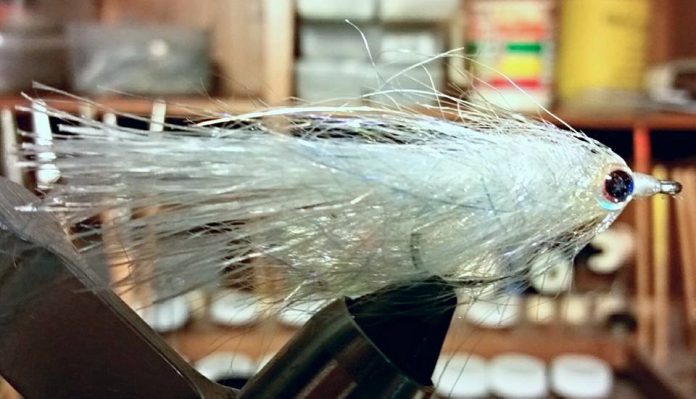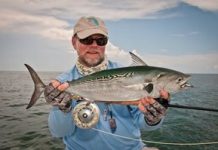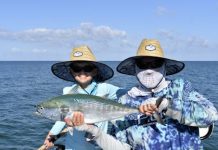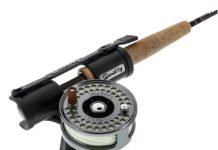 As the water cools and fishing activity on the flats heats up, are there times when you would like your fly to go deeper? We all love to see fish come up to the surface and slam a top water fly or popper, but sometime larger fish are more interested in having their dinner put closer to their nose as they lie with their belly against the sand.
As the water cools and fishing activity on the flats heats up, are there times when you would like your fly to go deeper? We all love to see fish come up to the surface and slam a top water fly or popper, but sometime larger fish are more interested in having their dinner put closer to their nose as they lie with their belly against the sand.
Deeper usually means a slower presentation is needed to entice a lunker to open wide. Can this be accomplished with a long rod that is best suited to casting small light flies on a calm day? Fortunately, a few old tricks and the advent of modern technology make this easy.
If you are just starting saltwater fly fishing, a floating, weight forward line may be all you have available, with your one fly rod and reel. This is certainly the best equipment for the beginner. Can we work with this combination to fish deeper? Yes, in a limited way. Adding weight to the fly is the simplest approach. If you tie your own flies, wrapping the hook shank with thin lead, or non-toxic wire would be the first step in construction. Vary the amount of weight so that you will have a variety for different depths.
How will you know which flies are weighted, and to what degree when they are in your box mixed with others that look the same? If you have three different weights, small, intermediate and heavy, wrap a small amount of colored thread close to the wing material when the head is finished. Blue for small, green for intermediate, and red for heavy would work. Your weighted creations will now stand out from the same unweighted patterns.
Weight near, or on the fly’s head is another option. Bead chain, lead, or non-toxic eyes have been used on Crazy Charlie and Clouser patterns for years. At least five weights are available from extra-small to large. These are attached with thread, using a figure eight configuration and some crazy glue to secure them to the hook shank. Painting eyes on these will make them more attractive. Recently, cone head and bead head flies have become popular. One of these is slid on the hook and secured against the hook eye, as the fly is finished. The cone head has the additional advantage, because of its narrow front and wider rear of helping the fly be more weedless or snag free.
The addition of weight to the forward section of flies will make them act more like a jig when the retrieve is stopped. As they drop, a strike is often triggered. Shorten your leader when using weighted flies. A heavier leader, especially in the butt section will assist in casting so you won’t have to “Chuck and Duck” to prevent from getting hit in the back of your head. Picking the line off the water on a more horizontal plane and then casting forward at a vertical plane will not only help your casting, but also prevent your weighted fly from hitting your fly rod tip. Clipping the tip with a weighted fly will weaken or break the tip section. This is one of the major causes of rod breakage.
The best approach for getting flies deep is to use a fly line designed for that purpose. Rather than a full sinking line, which is a casting nightmare, one with a sinking tip will satisfy all of your inshore needs. Older lines of this design seemed to have a hinge where the regular floating line joined the weighted tip section. This was very noticeable when casting.
Modern technology has produced some great lines. I have been using saltwater lines by Cortland and Rio that are a pleasure to cast, don’t have that hinge feeling and have a clear sinking tip. Cortland’s 444 Tropic Plus Ghost Tip Taper has a nine foot clear sinking section to which the butt portion of your leader is attached. The Powerflex Core QuickShooter line from Rio has a twelve foot clear forward section while the Powerflex Core Tarpon line has a fifteen foot clear section. When short leaders are used with these lines, the clear section will not spook fish. More importantly, a short leader allows the fly to more easily stay at the same level as the line. Using four feet of fluorocarbon of the proper strength may be all that is needed.
A little experimenting with leader lengths will be needed at first. Use the countdown method after you cast to get the desired depth. If you want to fish a little above a submerged grass flat and a count of twelve picks up some weeds, count to ten before the same retrieve is used to accomplish your goal. These lines are also much better to cast in our constant wind than their floating counterparts. When fishing where a school of fish is present, the smaller more aggressive ones are always closer to the surface. Your chances of getting a deep prowling lunker to take your fly will improve as your offering sinks.
Fishing a floating popper with a sinking tip line will give an effect that often is irresistible to finicky feeders. Your retrieve allows the popper to sink and when stopped will allow it to return to the surface much the same as a wounded baitfish. Ed, from Edgewater Products suggested this method to me some years ago, when discussing the versatility of some of their cell foam popper heads. This technique works!
Ideally, a second rod should be rigged with one of the above combinations allowing you to be able to have an instant choice to suite your needs. Give this method a try and stick with it. I know it will soon become an important part of your fly fishing armamentarium.
Capt. Pat Damico
St. Pete Beach
727-360-6466
pat4jaws@hotmail.com
- Captain’s Corner:Pat Damico - June 25, 2019
- Flat water makes seeing tarpon easier - May 17, 2017
- Warm rivers holding plenty of targets for fly fishermen - February 16, 2017











